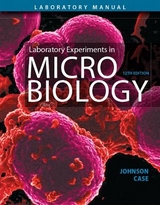
Laboratory Experiments in Microbiology
Pearson (Verlag)
978-0-321-99493-6 (ISBN)
- Titel erscheint in neuer Auflage
- Artikel merken
Containing 57 thoroughly class-tested and easily customizable exercises, Laboratory Experiments in Microbiology, Eleventh Edition, provides engaging labs with instruction on performing basic microbiology techniques and applications for undergraduate students in diverse areas, including the biological sciences, allied health sciences, agriculture, environmental science, nutrition, pharmacy, and various pre-professional programs.
The perfect companion to Tortora/Funke/Case’s Microbiology: An Introduction or any introductory microbiology text, the Eleventh Edition features fourteen new Part-opening Case Studiesthat introduce students to a real world scenario or health-oriented case that connects the lab exercises to an engaging, familiar context. Updates to the new ASM BSL-2 safety lab protocol enhance flexibility and customization options for the instructor. MasteringMicrobiology’s newly updated prelab quizzes along with MicroLab Tutors and Lab Technique Videos ensure students arrive prepared for each lab and provide additional review opportunities.
Ted R. Johnson is a professor of biology at St. Olaf College, a liberal arts college in Northfield, Minnesota, where he teaches courses in microbiology and immunology. He has taught at St. Olaf for 34 years and previously taught at Mankato State University. He received his master’s degree and his Ph.D in microbiology from the University of Illinois in Chicago, Illinois. While at St. Olaf College, he has developed and directed several semester abroad and interim programs. His research focuses on the immune response to virally induced cancer in various animal models. Christine L. Case is a registered microbiologist and a professor of microbiology at Skyline College in San Bruno, California, where she has taught for the past 44 years. She received her Ed. D. in curriculum and instruction from Nova Southeastern University and her M.A. in microbiology from San Francisco State University. She was Director for the Society for Industrial Microbiology (SIM). She received the ASM and California Hayward outstanding educator awards and SACNAS Mentor award. In addition to teaching, Chris contributes regularly to professional literature, develops innovative educational methodologies, and maintains a personal and professional commitment to conservation and the importance of science in society. Chris is also an avid photographer, and many of her photographs appear in this lab manual.
Part One Microscopy 1. Use and Care of the Microscope
2. Examination of Living Microorganisms
Part Two Handling Bacteria
3. Microbes in the Environment
4. Transfer of Bacteria: Aseptic Technique
Part Three Staining Methods
5. Preparation of Smears and Simple Staining
6. Negative Staining
7. Gram Staining
8. Acid-Fast Staining
9. Structural Stains (Endospore, Capsule, and Flagella)
10. Morphological Unknown
Part Four Cultivation of Bacteria
11. Isolation of Bacteria by Dilution Techniques
12. Special Media for Isolating Bacteria
Part Five Microbial Metabolism
13. Carbohydrate Catabolism
14. Fermentation
15. Protein Catabolism, Part 1
16. Protein Catabolism, Part 2
17. Respiration
18. Unknown Identification and Bergey’s Manual
Part Six Microbial Growth
19. Oxygen and the Growth of Bacteria
20. Determination of a Bacterial Growth Curve: The Role of Temperature
21. Biofilms
Part Seven Control of Microbial Growth
22. Physical Methods of Control: Heat
23. Physical Methods of Control: Ultraviolet Radiation
24. Chemical Methods of Control: Disinfectants and Antiseptics
25. Chemical Methods of Control: Antimicrobial Drugs
26. Effectiveness of Hand Scrubbing
Part Eight Microbial Genetics
27. Regulation of Gene Expression.
28. Isolation of Bacterial Mutants.
29. Transformation of Bacteria.
30. DNA Fingerprinting.
31. Genetic Engineering.
32. Ames Test for Detecting Possible Chemical Carcinogens.
Part Nine The Microbial World
33. Fungi: Yeasts and Molds
34. Phototrophs: Algae and Cyanobacteria.
35. Protozoa.
36. Parasitic Helminths
Part Ten Viruses
37. Isolation and Titration of Bacteriophages.
38. Plant Viruses.
Part Eleven Interaction of Microbe and Host
39. Epidemiology.
40. Koch's Postulate.
Part Twelve Immunology
41. Innate Immunity.
42. Agglutination Reactions: Slide Agglutination.
43. Agglutination Reactions: Microtiter Agglutination.
44. ELISA Technique.
Part Thirteen Microrganisms and Disease
45. Bacteria of the Skin.
46. Bacteria of the Respiratory Tract.
47. Bacteria of the Mouth.
48. Bacteria of the Gastrointestinal Tract.
49. Bacteria of the Urogenital Tract.
50. Identification of an Unknown from a Clinical Sample.
51. Rapid Identification Methods
Part Fourteen Microbiology and the Environment
52. Microbes in Water: Multiple-Tube Technique.
53. Microbes in Water: Membrane Filter Technique.
54. Microbes in Food: Contamination.
55. Microbes Used in the Production of Foods.
56. Microbes in Soil: The Nitrogen and Sulfur Cycles.
57. Microbes in Soil: Bioremediaton.
APPENDICES.
A. Pipetting.
B. Dilution Techniques and Calculations.
C. Use of the Spectrophotometer.
D. Graphing.
E. Use of the Dissecting Membrane.
F. Use of the Membrane Filter.
G. Electrophoresis.
H. Keys to Bacteria.
Index.
| Erscheint lt. Verlag | 29.1.2015 |
|---|---|
| Sprache | englisch |
| Maße | 230 x 280 mm |
| Gewicht | 970 g |
| Themenwelt | Medizin / Pharmazie ► Medizinische Fachgebiete ► Mikrobiologie / Infektologie / Reisemedizin |
| Naturwissenschaften ► Biologie ► Mikrobiologie / Immunologie | |
| ISBN-10 | 0-321-99493-0 / 0321994930 |
| ISBN-13 | 978-0-321-99493-6 / 9780321994936 |
| Zustand | Neuware |
| Informationen gemäß Produktsicherheitsverordnung (GPSR) | |
| Haben Sie eine Frage zum Produkt? |
aus dem Bereich



